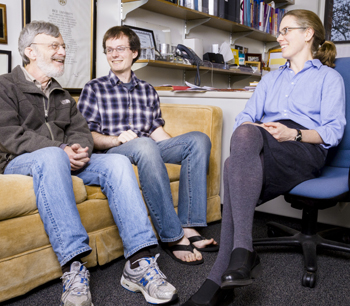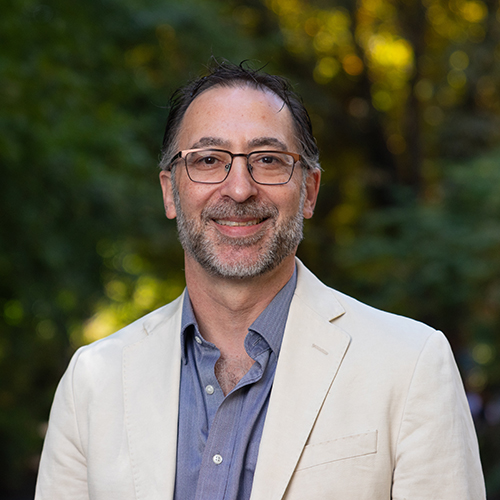Two years ago, biochemist Roy Black had an intriguing theory about the origins of life. One problem: he had nowhere to test it.
Black had spent his career at Amgen Corporation, studying enzymes that played a role in inflammatory diseases. A growing interest in origins-of-life questions led him to retire from Amgen to research those questions on his own dime. But he needed laboratory space and equipment. Through an Amgen connection, he contacted David Castner, professor of chemical engineering, who then put him in touch with Sarah Keller, professor of chemistry and associate dean for research activities in the College of Arts and Sciences.
“From Roy's first email, I could see that he was someone who had expertise and a fascinating topic he wanted to discuss,” says Keller. “When he came by and talked, I felt he would be a fantastic fit for our lab. I saw that the skills he brought would be hugely complementary.” Black joined Keller’s lab as a visiting scientist and is now an affiliate professor of bioengineering.

Keller recalls their first conversation with amusement. “In essence, Roy said, ‘I have this completely crazy idea for which I have some preliminary results but zero guarantee that it’s going to work.’ I think all of us had this feeling that the chance of success was very low, but it was such an interesting idea that I thought, ‘Why not?’ And then his crazy idea worked!”
Black’s “crazy idea” sought to answer ongoing questions about how the first cells survived. He explains that cells consist of “bags” that hold genetic material, such as DNA or RNA. It’s unclear how the genetic material first came together, and also unclear how the bags—made up of molecules that are unstable in salt—survived our salty oceans. “When the bags collapse in salt, it’s very dramatic,” says Black. “They form big clumps and just sink to the bottom of the test tube. You don’t need a microscope to see it.”
Black hypothesized that a symbiotic relationship between the RNA and the bags is central to the cell’s survival. “The core of my idea was that the pieces of RNA would cling onto the bag, and that’s how the RNA first came together but also how the bag would stay together. The RNA would help stabilize the bag against this salt effect. So you have this kind of mutual interdependence.”
"I think all of us had this feeling that the chance of success was very low, but it was such an interesting idea that I thought, ‘Why not?’ And then his crazy idea worked!”
Early experiments in Keller’s lab supported Black’s hypothesis. “When I mixed in pieces of the RNA right away, the clumps weren’t forming,” recalls Black. “I thought, ‘This is too good to be true.’” Roy repeated the experiment multiple times, figuring he must have made a mistake. Each time, the result was the same. “That was definitely a Eureka moment,” he says.
Since that early success, Black has been working to better understand the process through which RNA is helping the bags stay intact. Doctoral student Matt Blosser has collaborated with Roy in addition to doing his own physics dissertation research in Keller's lab.
“While helping Roy with some of my lab's equipment, Matt became curious about the questions Roy was asking,” says Keller. “Soon he started asking his own questions. He wasn’t assigned to work with Roy; the collaboration arose because of true intellectual interest and Matt’s intellectual input.”

For Blosser, who already listed Keller among his mentors, the opportunity to work with another experienced chemist has been an unexpected bonus. He is co-author on a paper about the research, published in the July 29 issue of the Proceedings of the National Academy of Sciences.
“I probably wouldn’t be working on a project like this if Roy hadn’t been here,” says Blosser. “The questions he’s asking weren’t on my radar beforehand. It’s an entirely new field for me to be exploring. It’s definitely some of the work that I’m most proud of as a graduate student.”
Black has been thrilled with Blosser’s involvement. He also has welcomed opportunities to share his expertise with other researchers. “I sort of feel like I need to earn my keep here,” he says with a laugh. “Granted, I’m not being paid, but I’m using the facilities and the tremendously bright people here as resources.”
Keller points out that Black's contributions have been numerous, from using his personal funds to purchase supplies for the project to contributing his valuable time, ideas, and passion.
“I think that a pretty common story is that some young hotshot comes to UW to start her or his career and does a risky experiment that uncovers new fundamental science,” Keller told UW Today. “Here we have an older hotshot who came to the UW at the end of his Amgen career to do a risky experiment that uncovers new fundamental science. I think the story also emphasizes that people don’t become scientists just because it is a good job—they do it because they love it. Roy worked for a year and a half straight, volunteering his time to the UW on something he didn’t get paid for, just for the joy and the curiosity. I am in awe. For many of us, including Roy, time is our most valuable resource, so the fact that he has given and continues to give his time to the UW is significant.”
Given the promise of Black’s research, he and Keller have been invited to submit a grant proposal to a prestigious private foundation, which could lead to substantial support for the project and the lab.
“When Roy’s project started, we didn’t know how long it would take to get results,” says Keller. “It’s amazing to think that this project that started out as a lark, with Roy coming to us as a volunteer with a wonderful, crazy idea, could now end up being something that brings money into the University of Washington through a grant. How great is that?”
For more about this research project, check out related stories at UW Today, The Economist, and the UW Daily.
More Stories

The Public Impact of Private Cities
Geography major Edwin Bai has researched private cities, developed by individuals and corporations, that "take the libertarian idea of low government regulation to the maximum."

Demystifying Quantum
In a physics course for non-STEM majors, Professor Miguel Morales teaches quantum mechanics without the advanced mathematics most quantum courses require.

The Curious Journey of Chinese Characters
Several Asian countries adapted the Chinese writing system—the oldest writing system still in use—for their own languages. In a new book, Professor Zev Handel shares how that happened.